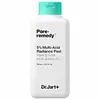What's inside
What's inside
 Key Ingredients
Key Ingredients

 Benefits
Benefits

 Concerns
Concerns

 Ingredients Side-by-side
Ingredients Side-by-side

Water
Skin ConditioningMacadamia Integrifolia Seed Oil
Skin ConditioningGluconolactone
Skin ConditioningPropanediol
SolventAlcohol Denat.
AntimicrobialPanthenol
Skin Conditioning1,2-Hexanediol
Skin ConditioningTromethamine
BufferingButylene Glycol
HumectantEthylhexylglycerin
Skin ConditioningAdenosine
Skin ConditioningPantolactone
HumectantGlycoproteins
Skin ConditioningMentha Viridis Leaf Oil
AstringentMentha Piperita Oil
MaskingEucalyptus Globulus Leaf Oil
PerfumingLimonene
PerfumingDisodium EDTA
Water, Macadamia Integrifolia Seed Oil, Gluconolactone, Propanediol, Alcohol Denat., Panthenol, 1,2-Hexanediol, Tromethamine, Butylene Glycol, Ethylhexylglycerin, Adenosine, Pantolactone, Glycoproteins, Mentha Viridis Leaf Oil, Mentha Piperita Oil, Eucalyptus Globulus Leaf Oil, Limonene, Disodium EDTA
Water
Skin ConditioningC9-12 Alkane
SolventButylene Glycol
HumectantGlycerin
HumectantCitric Acid
BufferingSodium Hydroxide
BufferingLactic Acid
BufferingHelianthus Annuus Seed Oil
EmollientTartaric Acid
BufferingIsononyl Isononanoate
EmollientLactobacillus Ferment
Skin ConditioningAlgae Extract
EmollientHoney
HumectantCaffeine
Skin ConditioningCamellia Sinensis Leaf Extract
AntimicrobialCurcuma Longa Root Extract
MaskingChamomilla Recutita Extract
Skin ConditioningLaminaria Saccharina Extract
Skin ProtectingPanthenol
Skin ConditioningSodium Hyaluronate
HumectantXanthan Gum
EmulsifyingCarbomer
Emulsion StabilisingSalicylic Acid
MaskingDi-C12-18 Alkyl Dimonium Chloride
Skin ConditioningHydrogenated Lecithin
EmulsifyingLaureth-4
EmulsifyingGlycine
BufferingSerine
MaskingGlutamic Acid
HumectantAspartic Acid
MaskingLeucine
Skin ConditioningAlanine
MaskingTyrosine
MaskingArginine
MaskingLysine
Skin ConditioningProline
Skin ConditioningPhenylalanine
MaskingThreonine
Isoleucine
Skin ConditioningValine
MaskingHistidine
HumectantParfum
MaskingLimonene
PerfumingCitronellol
PerfumingGeraniol
PerfumingLinalool
PerfumingCitral
PerfumingDisodium EDTA
Sodium Citrate
BufferingTocopheryl Acetate
AntioxidantBHT
AntioxidantPhenoxyethanol
PreservativePotassium Sorbate
PreservativeWater, C9-12 Alkane, Butylene Glycol, Glycerin, Citric Acid, Sodium Hydroxide, Lactic Acid, Helianthus Annuus Seed Oil, Tartaric Acid, Isononyl Isononanoate, Lactobacillus Ferment, Algae Extract, Honey, Caffeine, Camellia Sinensis Leaf Extract, Curcuma Longa Root Extract, Chamomilla Recutita Extract, Laminaria Saccharina Extract, Panthenol, Sodium Hyaluronate, Xanthan Gum, Carbomer, Salicylic Acid, Di-C12-18 Alkyl Dimonium Chloride, Hydrogenated Lecithin, Laureth-4, Glycine, Serine, Glutamic Acid, Aspartic Acid, Leucine, Alanine, Tyrosine, Arginine, Lysine, Proline, Phenylalanine, Threonine, Isoleucine, Valine, Histidine, Parfum, Limonene, Citronellol, Geraniol, Linalool, Citral, Disodium EDTA, Sodium Citrate, Tocopheryl Acetate, BHT, Phenoxyethanol, Potassium Sorbate
 Reviews
Reviews

Ingredients Explained
These ingredients are found in both products.
Ingredients higher up in an ingredient list are typically present in a larger amount.
Butylene Glycol (or BG) is used within cosmetic products for a few different reasons:
Overall, Butylene Glycol is a safe and well-rounded ingredient that works well with other ingredients.
Though this ingredient works well with most skin types, some people with sensitive skin may experience a reaction such as allergic rashes, closed comedones, or itchiness.
Learn more about Butylene GlycolDisodium EDTA plays a role in making products more stable by aiding other preservatives.
It is a chelating agent, meaning it neutralizes metal ions that may be found in a product.
Disodium EDTA is a salt of edetic acid and is found to be safe in cosmetic ingredients.
Learn more about Disodium EDTALimonene is a fragrance that adds scent and taste to a formulation.
It's found in the peel oil of citrus fruits and other plants such as lavender and eucalyptus. The scent of limonene is generally described as "sweet citrus".
Limonene acts as an antioxidant, meaning it helps neutralize free radicals.
When exposed to air, oxidized limonene may sensitize the skin. Because of this, limonene is often avoided by people with sensitive skin.
The term 'fragrance' is not regulated in many countries. In many cases, it is up to the brand to define this term. For instance, many brands choose to label themselves as "fragrance-free" because they are not using synthetic fragrances. However, their products may still contain ingredients such as essential oils that are considered a fragrance.
Learn more about LimonenePanthenol is a common ingredient that helps hydrate and soothe the skin. It is found naturally in our skin and hair.
There are two forms of panthenol: D and L.
D-panthenol is also known as dexpanthenol. Most cosmetics use dexpanthenol or a mixture of D and L-panthenol.
Panthenol is famous due to its ability to go deeper into the skin's layers. Using this ingredient has numerous pros (and no cons):
Like hyaluronic acid, panthenol is a humectant. Humectants are able to bind and hold large amounts of water to keep skin hydrated.
This ingredient works well for wound healing. It works by increasing tissue in the wound and helps close open wounds.
Once oxidized, panthenol converts to pantothenic acid. Panthothenic acid is found in all living cells.
This ingredient is also referred to as pro-vitamin B5.
Learn more about PanthenolWater. It's the most common cosmetic ingredient of all. You'll usually see it at the top of ingredient lists, meaning that it makes up the largest part of the product.
So why is it so popular? Water most often acts as a solvent - this means that it helps dissolve other ingredients into the formulation.
You'll also recognize water as that liquid we all need to stay alive. If you see this, drink a glass of water. Stay hydrated!
Learn more about Water